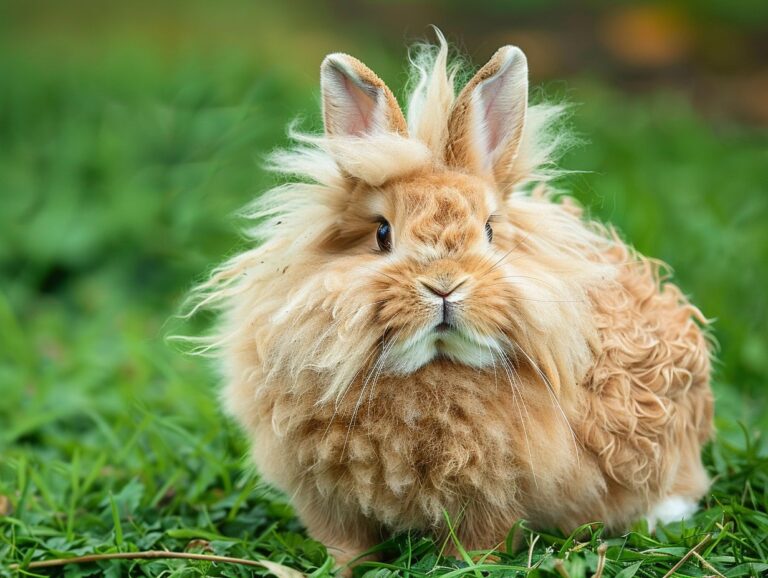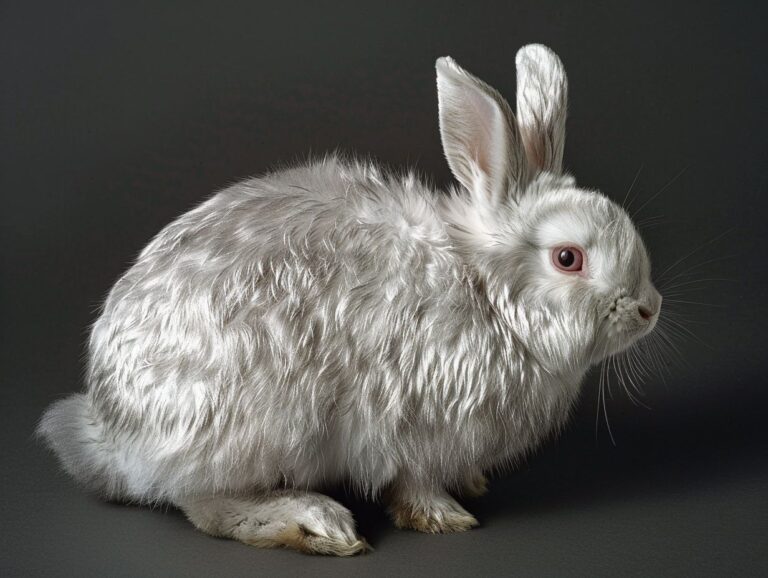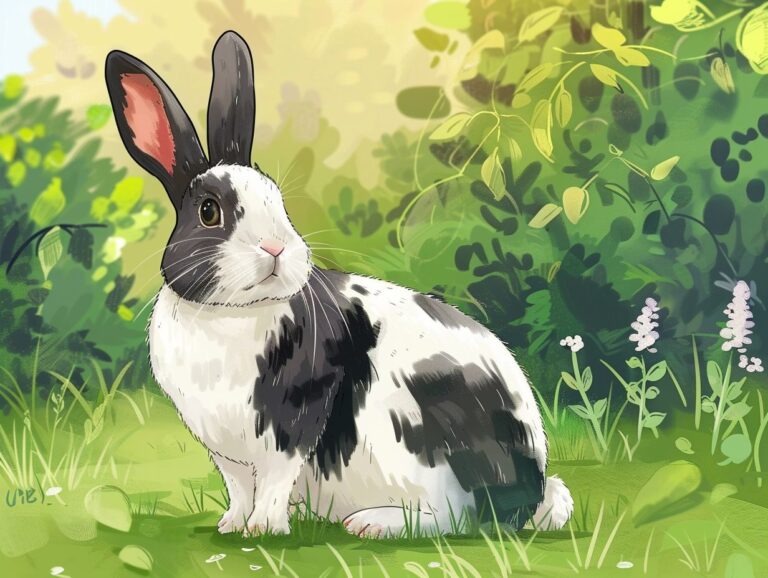Checkered Giant Rabbit Breed: Characteristics, Care, History, and Breeding Practices
Are you curious about the majestic Checkered Giant rabbit breed? In this comprehensive article, we will explore everything you need to know about these stunning rabbits – from their physical characteristics and fascinating history to essential care tips and breeding practices.
Discover the housing requirements, dietary needs, grooming techniques, and common health issues of Checkered Giant rabbits. Whether you’re a seasoned rabbit owner or considering adding one to your family, this article is a must-read for all rabbit enthusiasts.
Key Takeaways:
What Is the Checkered Giant Rabbit Breed?
The Checkered Giant Rabbit is a distinctive breed known for its striking markings and large size. Originating in France and Germany, this breed is favored for its unique appearance and friendly temperament.
These rabbits typically have a bold, vivid checkered pattern in black and white, lending them their eye-catching appearance. The breed’s size is another notable feature, with adults often weighing between 11 to 16 pounds. Their temperament is described as docile and calm, making them suitable as pets. Checkered Giants are believed to have been developed by breeders aiming to create a rabbit that stood out in shows, hence the emphasis on their unique markings. Over time, this breed has gained popularity among rabbit enthusiasts for its distinct blend of size, markings, and gentle disposition.
What Are the Physical Characteristics of Checkered Giant Rabbits?
Checkered Giant Rabbits are known for their large size, with adults typically weighing between 11 to 13 pounds. They have a distinctive checkered pattern on their coat, which can vary in color from black, blue, chocolate to lilac.
These rabbits are strikingly big, with a signature bold appearance. Their well-muscled bodies can measure around 24-30 inches in length and they stand tall on strong legs. The striking feature of their coat is the unique checkered pattern, usually in black and another color (blue, chocolate, or lilac), creating a mesmerizing contrast. Along with their impressive size, these rabbits have a dense, glossy coat that is exceptionally soft to the touch. The coat’s texture combined with the varying shades of color gives them a regal and distinguished look.
What Is the History of Checkered Giant Rabbits?
The history of Checkered Giant Rabbits dates back to their development in the early 20th century, with breeders like Otto Reinhardt from Germany and Reinfalz from France playing key roles in establishing the breed. The American Rabbit Breeders Association (ARBA) officially recognized them in 1930.
These rabbits, known for their distinctive coat pattern of bold checkered markings, have roots that extend deeply into the rabbit breeding world of Europe. Otto Reinhardt, a notable figure in this domain, meticulously bred these rabbits in Germany, while Reinfalz, hailing from France, contributed significantly to their refinement.
The Checkered Giants’ journey to recognition by the ARBA was a significant milestone in solidifying their position in the rabbit breeding community. This formal recognition not only validated the breed’s unique characteristics but also enabled enthusiasts to showcase these rabbits in various competitions and exhibitions.
How to Care for Checkered Giant Rabbits?
Caring for Checkered Giant Rabbits involves providing a balanced diet, regular grooming sessions, sufficient exercise, a spacious hutch, and positive training experiences.
Regarding their diet, Checkered Giants need a mix of hay, fresh vegetables, high-quality pellets, and fresh water daily.
Grooming these large rabbits is essential, using a slicker brush, nail clippers, and a gentle grooming spray to maintain their coat and hygiene. Check out more about the American Rabbit breed.
For exercise, allow them plenty of space to hop around indoors or explore a secure outdoor enclosure.
The hutch should be large enough for them to stretch out comfortably, with bedding changed regularly and proper ventilation.
Training these intelligent rabbits involves using treats, clicker training, and consistency to reinforce desired Continental rabbit breed behaviors.
By paying attention to these key aspects, you can ensure your Checkered Giant Rabbits live a healthy and happy life.”
What Are the Housing Requirements for Checkered Giant Rabbits?

Indoor housing for Checkered Giant Rabbits should include a hutch with ample space for them to stretch and move comfortably. Opt for a cage setup that allows for separate areas for resting, feeding, and playing. Incorporating enrichment toys helps stimulate their natural instincts and prevents boredom.
For outdoor housing, ensure the hutch is predator-proof and well-ventilated. Consider placing the hutch in a shaded area to protect the rabbits from extreme weather conditions. Providing hiding spots and tunnels in their outdoor setup mimics their natural habitat.
What Do Checkered Giant Rabbits Eat?
Checkered Giant Rabbits thrive on a balanced diet that includes high-quality hay, fresh vegetables, and a small amount of pellets. Brands like Oxbow Bunny Basics Adult Rabbit Food are recommended for their nutritional needs.
Hay is a crucial part of a Checkered Giant Rabbit’s diet, providing essential fiber needed for proper digestion and dental health. Fresh vegetables like dark leafy greens, carrots, and bell peppers offer important vitamins and minerals. Pellets should be given in moderation to avoid obesity, and opt for those with high fiber content to support a healthy digestive system.
When choosing pellets, look for options that contain Timothy hay as the first ingredient and avoid those with added sugar or artificial colors. Brands such as Small Pet Select Timothy-Based Rabbit Food or Supreme Science Selective Rabbit Food are also popular choices among rabbit owners for their superior quality and nutritional benefits.
How to Groom Checkered Giant Rabbits?
Grooming Checkered Giant Rabbits involves regular brushing to maintain their coat’s health and prevent issues like matting. It’s essential to check for any signs of back problems and schedule routine vet checkups for their overall well-being.
Regarding brushing these gentle giants, opt for a slicker brush to effectively remove loose fur and prevent tangles. Brush in the direction of hair growth to avoid causing discomfort. For those with dense fur patches, a comb can be handy in detangling. Regular grooming not only keeps their coat pristine but also helps detect any abnormalities early on.
- Being attentive to any changes in their behavior, such as reluctance to be touched on certain areas, can indicate underlying back issues. Consult a vet immediately if you notice anything unusual.
- Establishing a grooming routine early on can make the process more comfortable for both you and your rabbit. Make it a bonding experience by offering treats and gentle strokes during grooming sessions.
Remember, a healthy coat is a reflection of overall well-being for your furry friend. Routine vet visits play a crucial role in ensuring your Checkered Giant Rabbit’s health remains in top condition. By incorporating these grooming practices into your pet care routine, you can keep your rabbit happy and healthy for years to come.
What Are the Common Health Issues of Checkered Giant Rabbits?
Checkered Giant Rabbits may be prone to common health issues such as digestive problems and certain genetic conditions. Understanding their lifespan and potential health concerns is crucial for providing optimal care.
Regarding their digestive system, Checkered Giant Rabbits can suffer from conditions like Gastrointestinal Stasis, where the gut motility slows down, leading to a potentially life-threatening situation. Ensuring they have a diet rich in fiber is essential to prevent this issue. Genetic conditions, such as dental malocclusion, where the teeth don’t align properly, can also affect these rex rabbit breeds.
Regular check-ups with a knowledgeable veterinarian can help in early detection and management of any developing health problems. Taking preventative measures, such as providing a spacious and stimulating environment for physical activity and mental enrichment, can contribute to their overall well-being.
How to Prevent and Treat Common Health Issues?
Preventing and treating common health issues in Checkered Giant Rabbits involves regular veterinary checkups, a balanced diet, and sufficient exercise. Early detection and prompt treatment are key to ensuring their well-being.
Regular vet visits play a vital role in identifying any health issues early on, allowing for timely interventions that can prevent complications later.
Diets rich in fiber and fresh vegetables are essential for maintaining optimal digestive health in Checkered Giants. Incorporating plenty of exercise into their daily routine helps prevent obesity and keeps their musculoskeletal system healthy. Observing your rabbit for any changes in behavior, appetite, or stool consistency can alert you to potential health concerns that should be promptly addressed.
How to Breed Checkered Giant Rabbits?

Breeding Checkered Giant Rabbits requires careful consideration of age, genetics, and breeding practices. Experienced breeders play a vital role in ensuring successful breeding outcomes.
Checkered Giant Rabbits reach breeding age around 7-9 months, with females usually ready earlier than males. When selecting breeding pairs, it’s crucial to assess genetic traits to avoid hereditary issues. Breeders focus on maintaining genetic diversity to enhance overall health and vigor of the offspring.
- By following responsible breeding techniques, such as regular health checks and proper nutrition, breeders can maximize the chances of producing healthy and robust litters.
- Monitoring the mating process closely and providing a stress-free environment are key components in successful breeding.
What Is the Ideal Breeding Age for Checkered Giant Rabbits?
The ideal breeding age for Checkered Giant Rabbits typically ranges from six to eight months, considering both the male and female rabbits. It’s essential to consult experienced breeders for guidance on optimal breeding practices.
When determining the appropriate breeding age range for Checkered Giant Rabbits, it’s crucial to consider various factors that can greatly influence the success of the breeding process. Factors such as the overall health, weight, and genetics of the rabbits play a significant role in determining when they are ready to breed. Proper nutrition and housing conditions are vital in ensuring the rabbits are in prime reproductive health.
Consulting with experienced breeders can provide valuable insights into assessing the maturity of your rabbits for breeding purposes. Experienced breeders can offer advice on the ideal age to commence breeding, as well as tips on monitoring the reproductive cycles of your rabbits. They can also guide you on how to create a suitable breeding environment that is conducive to successful mating and pregnancy.
What Are the Best Breeding Practices for Checkered Giant Rabbits?
Implementing the best breeding practices for Checkered Giant Rabbits involves selecting compatible pairs, understanding genetic traits, and ensuring proper care during the breeding process. Working closely with knowledgeable breeders can enhance breeding outcomes.
Genetic diversity plays a crucial role in maintaining the health and vigor of the Checkered Giant Rabbit breed. When choosing pairs for breeding, it is essential to consider complementary genetic traits to avoid inbreeding and genetic abnormalities. Experienced breeders often emphasize the importance of broadening the gene pool through strategic pairings to produce robust offspring.
Proper breeding care involves providing a stress-free environment, monitoring the doe’s health closely during pregnancy, and ensuring the newborn kits receive adequate nutrition and warmth. Experienced breeders can offer guidance on managing the breeding process to optimize litter size and overall wellness.
How to Care for Pregnant and Newborn Checkered Giant Rabbits?
Providing care for pregnant and newborn Checkered Giant Rabbits involves ensuring a comfortable nesting environment, monitoring the mother’s health, and offering a nutritious diet. Consultation with experienced breeders is essential for proper care.
When preparing for the arrival of newborn Checkered Giant Rabbits, it’s crucial to set up a cozy nest with soft bedding for the mother to rest and nurse her young. Checking on the doe’s well-being regularly is necessary to catch any signs of distress or health issues early on.
- Keeping track of her weight gain
- Monitoring her behavior
- Observing any changes in appetite
Careful attention to her needs can prevent complications during pregnancy and delivery.
Ensuring the doe receives a balanced diet rich in essential nutrients like hay, leafy greens, and pellets is vital for her health and the development of her offspring. Offering fresh water at all times is also key to keeping her hydrated and maintaining her milk supply.
- Regular veterinary check-ups
- Supplements if necessary
- Avoiding sudden diet changes
can further support the mother’s well-being.
What Are the Unique Characteristics of Checkered Giant Rabbit Breed?
The Checkered Giant Rabbit breed is known for its friendly and active personalities, making them popular choices as both show rabbits and family pets. Their engaging temperament and striking appearance set them apart from other rabbit breeds.
One of the key characteristics of Checkered Giant Rabbits is their charismatic nature. These rabbits are known for their sociable behavior, often forming strong bonds with their owners. Their inquisitive personalities make them a joy to interact with, whether in a show setting or as beloved companions at home. Along with their friendly demeanor, Checkered Giants are also prized for their distinct coat pattern, which features distinctive checkered markings that add to their charm and appeal.
What Are the Pros and Cons of Owning a Checkered Giant Rabbit?

Checkered Giant Rabbits are known for their gentle demeanor, making them wonderful companions for families of all ages. Their adaptability allows them to thrive both inside the house and in a secure outdoor area, providing flexibility for pet owners. These rabbits are also quite entertaining, with their playful antics and curious nature keeping owners amused and delighted.
One challenge to be mindful of is the need for a large living space. These rabbits require ample room to move around, so a spacious enclosure or hutch is essential to ensure their well-being and happiness. Learn more about the tan rabbit breed and their specific requirements.
Like all pets, Checkered Giants may be susceptible to certain health conditions. Regular veterinary check-ups and proper nutrition are vital to keeping these rabbits healthy and thriving for years to come.
Frequently Asked Questions
What are the characteristics of the Checkered Giant Rabbit breed?
The Checkered Giant Rabbit breed is one of the largest recognized breeds, weighing between 11-14 pounds. They have a distinct checkered pattern on their fur, with a white base and black or blue spots. They have long, powerful hind legs and a wide head with upright ears.
How should I care for my Checkered Giant Rabbit?
Checkered Giant Rabbits require a spacious living area, as they are an active breed. They should have access to fresh hay, vegetables, and a high-quality pellet food. Regular grooming is also important to keep their fur clean and prevent matting.
What is the history of the Checkered Giant Rabbit breed?
The Checkered Giant Rabbit breed was developed in the early 1900s in England by crossing different breeds to create a larger rabbit for meat production. They were later recognized as a show breed in the 1920s and have since gained popularity as a pet breed.
What are some breeding practices for Checkered Giant Rabbits?
Checkered Giant Rabbits are known to be good mothers and produce large litters. It is important to choose a healthy and well-tempered pair for breeding, and to provide proper nesting and care for the mother and her kits. Breeding should also be done responsibly and with the intention of improving the breed.
Are there any health concerns specific to Checkered Giant Rabbits?
Like all rabbits, Checkered Giants are prone to dental issues and should have their teeth checked regularly. They are also susceptible to obesity, so it is important to monitor their diet and exercise. It is also recommended to spay or neuter your rabbit to prevent health issues and unwanted litters.
Can I show my Checkered Giant Rabbit?
Yes, the Checkered Giant Rabbit breed is recognized by several rabbit breed associations and can be shown in shows and competitions. It is important to have your rabbit evaluated by a judge and follow the specific show standards for this breed.







